Ernesto Cardenal: The Poet that Melds God and Science
The depth of Ernesto Cardenal’s personality has never been fully understood. Revolutionary, religious leader, sculptor, painter and teacher; a Marxist, but loyal to God. That’s Ernesto Cardenal according to the people who know him and have worked with him.
By Franklin Villavicencio (Confidencial)
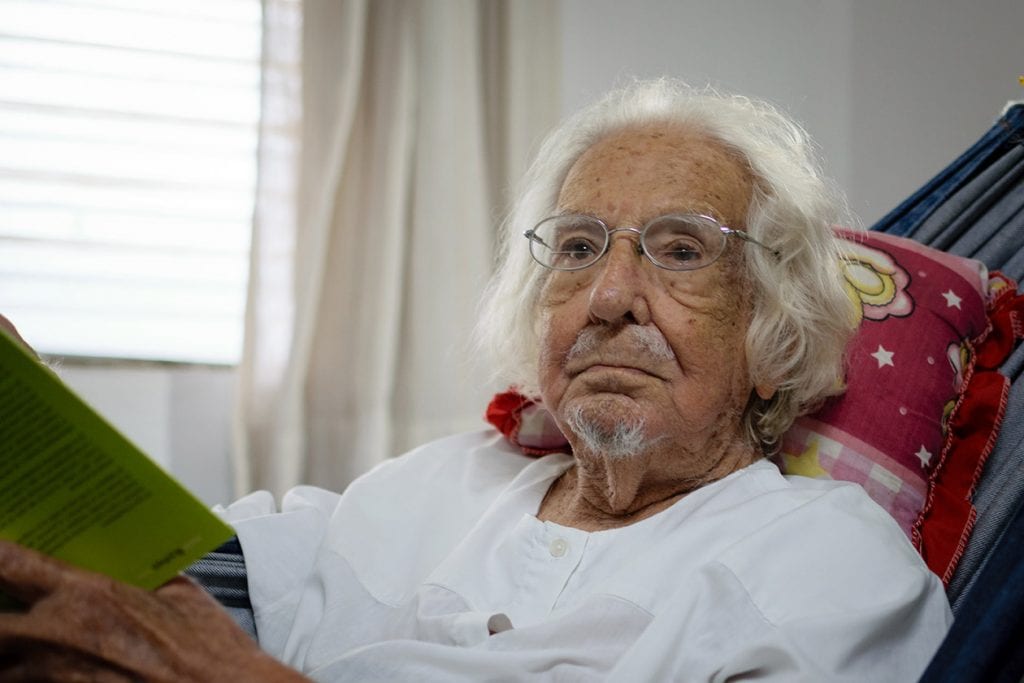
HAVANA TIMES – A man with long hair, a full beard and wire-rimmed glasses is preparing to begin a baptism ceremony. He’s not a conventional priest, with lengthy sermons and heavy solemnity. This Father skips over the ritual that any other cleric would perform, and prays that the spirits of “Somoza, capitalism and greed” do not touch the life of the small being that is about to receive their first sacrament.
The priest is Ernesto Cardenal, a man who talks about the cosmos in the middle of his homilies, who reads books about science because this brings him closer to God, and who believed in the Sandinista Revolution, even though it caused him to go outside the church canons.
Niu talked with the circle of people closest to Ernesto Cardenal, asking them to tell us about his life. Each anecdote added a brush-stroke to the portrait of one of the most important bards of Latin American poetry. Revolutionary, religious figure, sculptor, painter and teacher; a Marxist who is loyal to God. This is Ernesto Cardenal, according to those who know him and have worked with him.
The first verses
In his search for a personal style, young Ernesto was influenced by the poetry of Pablo Neruda. The freshness of the young girls and unrequited love made up the meters of his first verses. But God was present too, a God who “pursued” him. Caught in a dilemma, he wanted to lead two lives: “one of them conjugal, and the other religious”, as he wrote in his autobiography Vida Perdida [“Lost Life”], published in 1999. He thought that selecting either one of these options would be a catastrophe, since it would mean renouncing the other.

In the end, he chose to dedicate himself to God and entered monastic life under the Trappist Order. He arrived at the monastery in Gethsemani, Kentucky, in 1956, and from the time he got on the plane he felt that he was detaching himself from the world and coming closer to God. “You can’t imagine what a joyous trip it was! Picture the exact feeling of a wedding trip,” he wrote in a letter, days after arriving at the cloisters.
The Trappist Order is a religious institution based on contemplation and a life of austerity. Members of the order can’t be photographed, and they’re forbidden to publish or write books. Nonetheless, Thomas Merton, who became Ernesto Cardenal’s spiritual father, was the exception with several published works.
Cardenal’s connection to Merton was born long before the monastery. While he was studying American Literature in Columbia, he had read on repeated occasions about the Trappist monk; years later, he would meet him in the Kentucky monastery.
Dedicating himself to God
In the entire course of his trip to this new religious life, Ernesto Cardenal continued to feel that “the hand of God” was guiding him. Upon arriving at his destination, a nearly bald man introduced himself: “I’m the teacher for the novices.” The poet discovered later that this man was Thomas Merton.
Ceasing to write was one of the requirements for entering the monastery. In regard to Merton’s inquiries, Cardenal responded that he had also renounced this before entering the order. “In order to really deliver myself over to God,” Cardenal wrote in his autobiography, “I needed to renounce everything.”
He had already given up a lot from his past: first, the comfortable life (he was born into the heart of one of the most respected families in the country and grew up in the House of Lions, a neoclassic mansion now known as the House of the Three Worlds in Granada); then the beauty of the young girls; and now his art. His rebellious character coincided with that of his mentor’s, Thomas Merton. Merton told him this on repeated occasions that he should try to fulfill the dictates of the order for becoming a religious leader so that later he could found a contemplative community in Nicaragua authorized by the Church. This was the prelude to Solentiname.
The mystical archipelago
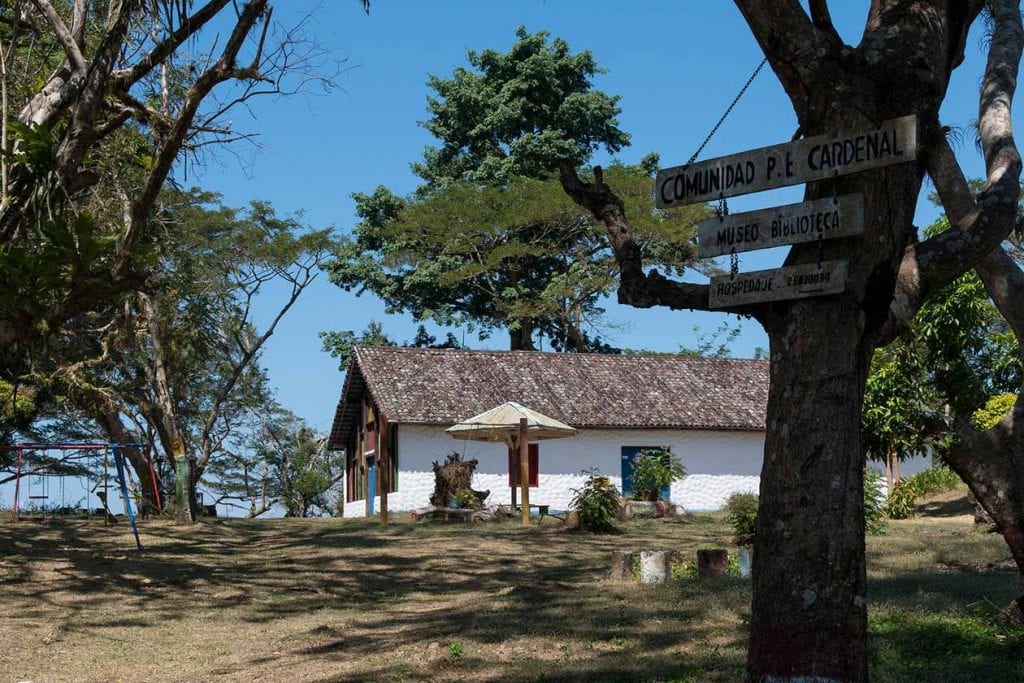
Bosco Centeno came to Solentiname in 1973. He was in love with Esperanza Guevara, a native of the island community. At the time, Ernesto Cardenal had already established a contemplative community in the zone. The community had become a haven for artists, and also guided the rural residents to a knowledge of art.
Centeno was a city boy who was trying to adapt to the rural life. He became a fisherman and a hunter, later gave classes to the residents and even learned to make handicrafts. Before coming to the archipelago, he had heard talk about a poet priest who had founded a contemplative community in a “mystical” archipelago.
He stumbled upon a small world of its own in Solintename, where young people in white cotonas [a kind of smock, traditional in Nicaragua], blue jeans and sandals who would sit down to read the Bible and compare each passage to the political situation of that era. The Romans were the US Empire, and Herod was usually considered to be Anastasio Somoza Debayle, then the nation’s dictator.
But the greatest challenge that Solentiname presented to Bosco Centeno was the decision to become part of the Sandinista Revolution. His commitment was influenced by his stay on the archipelago, where he was surrounded by books that had been banned as Communist and attended long philosophical chats on the transformation of the tumultuous country that was Nicaragua at that time.
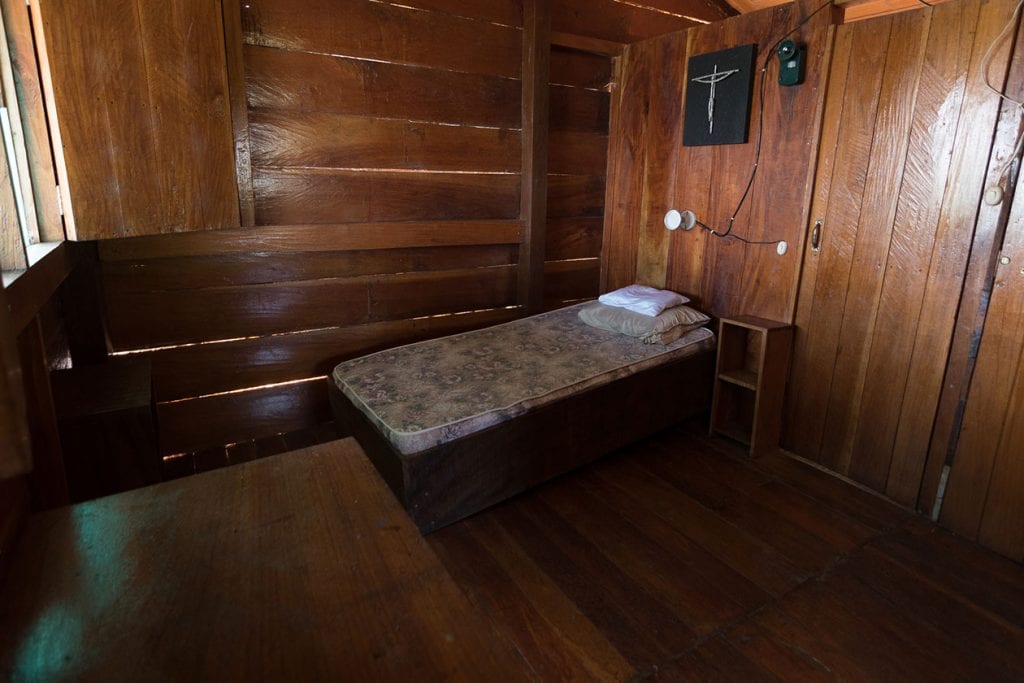
In 1977, Ernesto Cardenal mentioned to Centeno that there was a mission to be carried out headed by the Sandinista Front. Right away, he began preparing to attack San Carlos, together with other young people from the community. This daring attack was one of the sparks that ignited the flames of the insurrection.
Cardenal understood that the only way to end the years of dictatorship was via the use of arms. “He knew there was no other option against Somoza,” Centeno commented.
The Revolution triumphed, and with it the poet entered a new phase of his life. Bosco Centeno became a lieutenant colonel, and Ernesto Cardenal was made Minister of Culture.
The revolution in cultural life
The life of this priest and poet seems to have been shaped by Destiny. At least that’s what Luz Marina Acosta, Cardenal’s assistant for 38 years, believes.
Following the fall of the last Somoza, all those who had previously been underground began to meet up again. Luz Marina had known Cardenal before, and one month after the revolutionary triumph she approached him to say hello and share that feeling of “reuniting.”
Upon seeing his old friend again, Cardenal asked her: “What are you going to do?” She answered that she didn’t know. Later, he invited her to come work in the recently founded Ministry of Culture since he was looking for staff to work in the institution. The poet told her to go see Vidaluz Meneses, Vice Minister of Culture, to be assigned to a post.
Meneses, upon seeing that Acosta knew Ernesto Cardenal, felt that she was the person best suited to be his assistant. Since that day at the end of July, 1979, she’s remained in this job.
Acosta describes Ernesto Cardenal as an exceptional man: introverted and abstemious. There are only two things that make him happy – his books and his hammock. He doesn’t like noise, and at 93, which he marked on January 20, 2018, he continues to lead a monastic life. His assistant believes that a part of him remained tied to the Trappist monastery he once belonged to.
During Acosta’s time at the Ministry of Culture, “el Padre” as his subordinates called him would spend the very minimum on the trips he took as Minister and scrupulously return any money that was left over.
The work of the Ministry of Culture was complicated. There were many limitations in terms of staff, but above all economically. It was the first time that an institution had been founded in Nicaragua dedicated to the cultural promotion of the country. At that time, the central government believed that “culture” meant only “art”. It fell to the team lead by Cardenal to change that frame of mind.
Amelia Barahona worked in the Assets Office while Cardenal was minister. She states that the poet was never authoritarian, nor did he impose his own views. He opened up “the playing field” to anything that the different leaders proposed. “Ernesto’s work, in addition to being the Minister, was to promote the Revolution outside the country,” Barahona declares.
The closing of the ministry
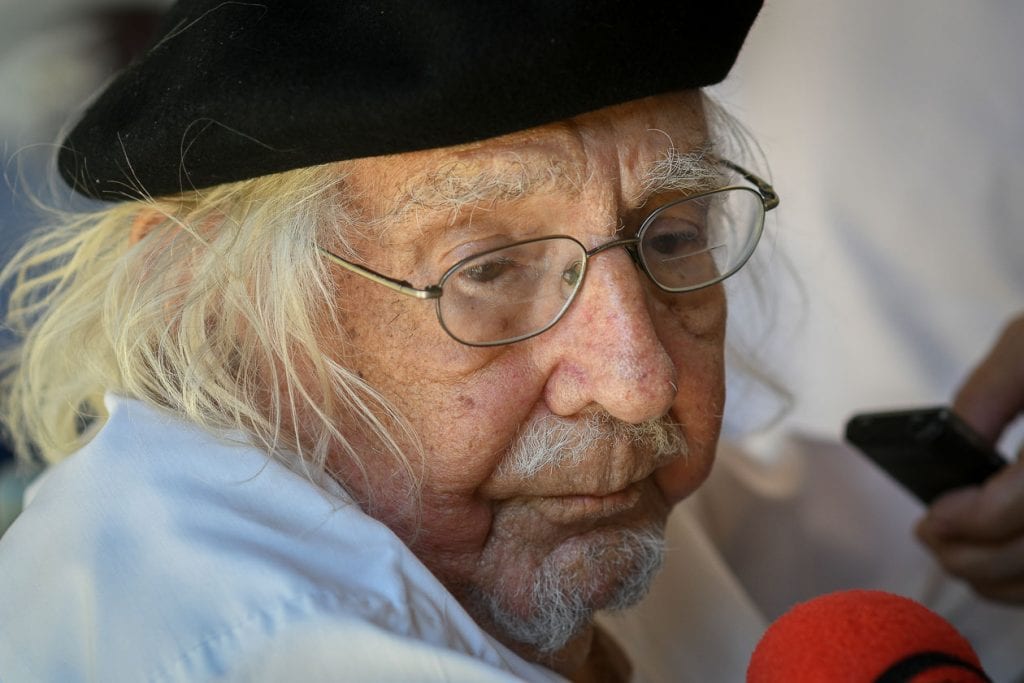
The Ministry of Culture was closed in 1988 for “lack of funding.” At least, those were the reasons given by the government of the time, then led by Daniel Ortega. When informed of this, the first thing that Amelia Barahona asked was if the Minister had been told. He didn’t know anything about it.
From the time of that episode, Barahona relates, a series of “encounters” began with Rosario Murillo, now Vice President of Nicaragua. Then, in 1989, a year after the closing of the ministry that Cardenal had led, the Nicaraguan Institute of Culture was opened, with Murillo at its head.
To Barahona, the closing of the ministry wasn’t due to lack of funds, but was a “political move.”
“If you don’t have the money to run an institution, why would you create another like it with the same mission and the same people?” she asks.
When informed about the closure of his project, Ernesto Cardenal remained unfazed. His spiritual nature led him to accept life’s occurrences as part of a natural cycle. When he returned from a trip to Japan he found that the Ministry had been dismantled. They left him nothing but a car, his assistant and a tiny office located on kilometer 14 of the Masaya highway. Meanwhile, the Institute of Culture run by Murillo was being born, and decrees were being drafted to make it official.
“Persecuted for his politics”
The day that Luz Marina Acosta found out about the February 2017 lawsuit leveled against the poet – a court order that Ernesto Cardenal should pay $800,000 to Nubia del Socorro Arcia Mayorga for damages – she was afraid to tell him for fear the shock might kill him. She went to see Sergio Ramirez, the well-known writer who was also Cardenal’s friend and neighbor. Ramirez left his house and walked over to where Ernesto lived. He found him in his monastic bedroom, furnished with a cot, a rocking chair and a bookshelf.

“Nothing else to be done, Poet,” Ramirez told him. “It’s only a few steps – you can come over to my house with your books. Tulita, my wife, will be most happy to see you,” he commented ironically.
It was the most delicate way of giving him the news.
Beginning this day, Cardenal became filled with anxiety. His assistant thought about taking him to her house, but she was concerned that such a move would make him even sicker since he prizes his solitude and his independence above all other things.
At the beginning of March 2017, following the lawsuit, Cardenal left for Germany on a visit. He was reluctant to go, but Luz Marina told him he should leave. During this visit he received an Honorable doctorate from the University of Wuppertal.
“I told him, ‘Go [to Germany]’ So that the world could see that he’s received honors from all over, even though here they treat him like shit, give him a life full of harassment,” was his assistant’s verdict.
[The suit has bounced back and forth in the Nicaraguan courts, with no clear resolution to date.]
The poet lives alone in his house in Los Robles, and even at 93 he hasn’t stopped writing. He gets up at 3 am every day to pray, and generally lives as he would in the Gethsemani Trappist monastery: given over to the contemplative life. Only one thing has changed in his choice of clothing: he’s traded his sandals for Crocs. It was Luz Marina who accomplished the difficult task of convincing him to make this switch.
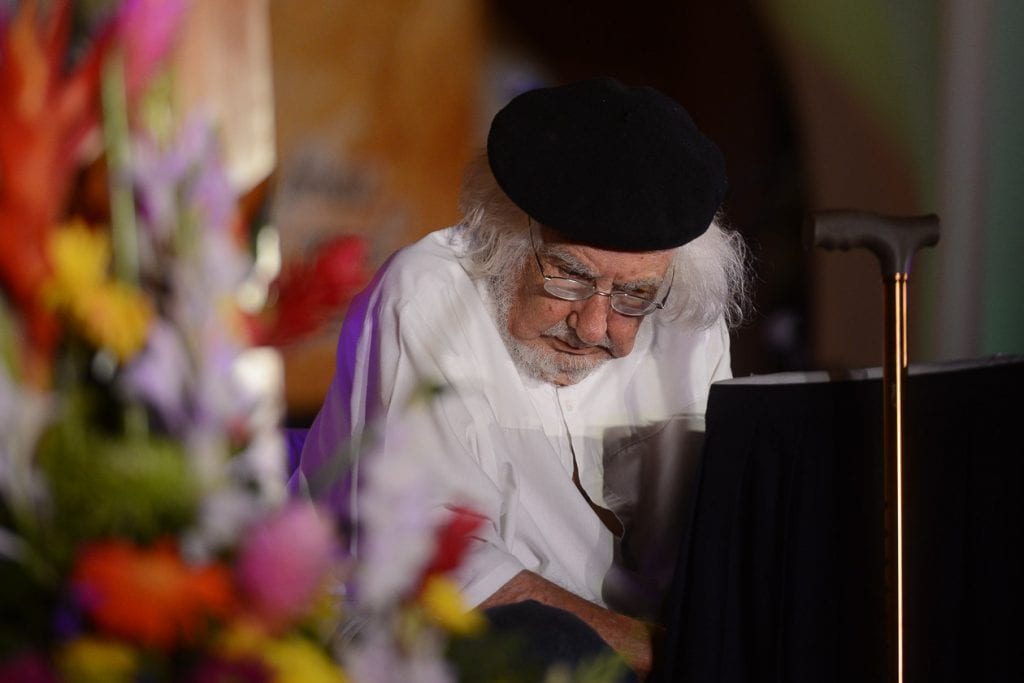
His room maintains the same essential setup as when he slept in Solentiname: a bed pushed against the wall, a shelf of books, a crucifix and his desk. The poet spends the afternoons in his hammock, hung between the four walls of his room, and usually sleeps. The universe of Ernesto Cardenal is defined by these four walls. The remaining areas of his modest house, full of sculptures and beautiful primitive paintings, are strange to him.
His mind is clear, despite his age. So much so, that he finished reading the latest novel El cielo llora por mi [“The sky weeps for me”] by his friend and neighbor Sergio Ramirez in just a few days. He’s also learned to use an iPad to read another kind of literature that he loves: scientific journal articles. Each week he downloads the numbers and editions of all the scientific advances published by the academies. He hasn’t stopped writing either, and it’s possible that he’ll publish a new work this year.
“I’m always writing. Nothing else is left for me. Reading a lot, and writing when I have something to say.
“My poetry is original. I don’t know of anyone in the world who is writing poetry inspired by science. One of those science-based poems is the one I just read (Asi en la Tierra como en el Cielo – “On earth as it is in heaven”). It’s about the cosmos, the mystery of creation, God’s creation, which is ever revealed to us as greater.
“At my age I don’t plan anything. But I write whenever I have something to write. Always less and with less frequency.”
-From an Interview with Ernesto Cardenal, January 19, 2018
